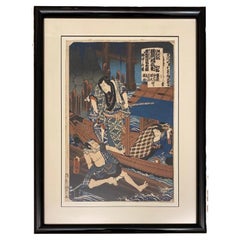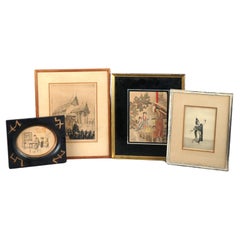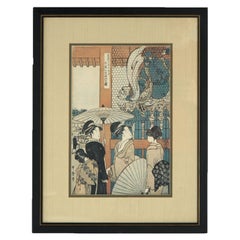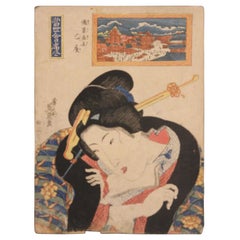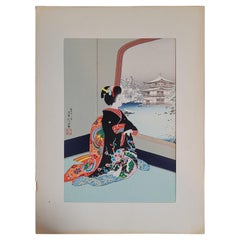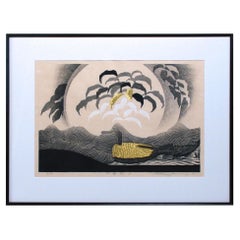Japanese Woodblock Prints
Antique 19th Century Japanese Edo Prints
Wood, Paper
20th Century Prints
Wood
20th Century Prints
Paper
Early 20th Century Prints
Paper
Early 1800s Edo Portrait Prints
Woodcut
Early 20th Century Japanese Other Prints
Paper
Early 20th Century Asian Prints
Paper
Antique Late 19th Century Japanese Prints
Paper
Vintage 1980s Japanese International Style Prints
Paper
20th Century Prints
Paper
Antique 19th Century Meiji Prints
Paper
1860s Edo Portrait Prints
Woodcut
1920s Edo Figurative Prints
Ink, Rice Paper, Woodcut
Early 20th Century Asian Prints
Paper
Early 20th Century Asian Prints
Paper
Antique 19th Century Japanese Prints
Paper
Early 20th Century Asian Prints
Paper
Mid-20th Century Japanese Prints
Paper
20th Century Japanese Prints
Paper
Early 20th Century Japanese Prints
Paper
Antique Mid-19th Century Japanese Edo Prints
Paper
Mid-20th Century Japanese Mid-Century Modern Prints
Paper
Antique Mid-19th Century Japanese Prints
Paper
Antique Late 19th Century Japanese Meiji Prints
Paper
Antique Early 19th Century Japanese Prints
Paper
Early 20th Century Japanese Prints
Paper
Antique 19th Century Japanese Meiji Prints
Paper
1920s Edo Figurative Prints
Ink, Rice Paper, Woodcut
Vintage 1930s Japanese Showa Prints
Paper
20th Century Japanese Showa Prints
Paper
Vintage 1930s Japanese Showa Prints
Wood, Paper
Antique Early 19th Century Japanese Prints
Paper
Antique Early 19th Century Japanese Prints
Paper
Antique Early 19th Century Japanese Prints
Paper
Antique 19th Century Japanese Prints
Paper
Antique Mid-19th Century Japanese Prints
Paper
Antique Mid-19th Century Japanese Prints
Paper
Antique Mid-19th Century Japanese Prints
Paper
1850s Edo Figurative Prints
Paper, Ink, Woodcut
Vintage 1980s Japanese Modern Prints
Glass, Wood, Paper
Vintage 1930s Japanese Showa Prints
Paper
1850s Edo Landscape Prints
Woodcut
Antique 1880s Japanese Prints
Paper
Antique Early 19th Century Japanese Prints
Paper
Antique Mid-19th Century Japanese Prints
Paper
Antique Early 19th Century Japanese Prints
Paper
20th Century Japanese Showa Prints
Paper
Antique Mid-19th Century Japanese Prints
Paper
Antique 19th Century Japanese Prints
Paper, Wood
Antique 19th Century Japanese Prints
Paper
Antique 19th Century Japanese Meiji Prints
Paper
19th Century Edo More Prints
Paper, Woodcut
20th Century Japanese Edo Prints
Paper
Antique Mid-19th Century Japanese Prints
Paper
20th Century Japanese Showa Prints
Paper
Antique 1880s Japanese Prints
Paper
1860s Edo Figurative Prints
Ink, Paper
20th Century Japanese Showa Prints
Paper
Antique 19th Century Japanese Prints
Paper
Antique 19th Century Japanese Prints
Glass, Wood, Paint, Paper
- 1
- ...
Looking for Original Japanese Woodblock Prints?
For concision, power and delight, it’s hard to beat Japanese woodblock prints, the products of an artistic tradition that is aging very well indeed.
The genre, unique to Japan, grew out of 17th-century developments in printing and book publishing. The form became known as “picture of the floating world,” an evocative name that captures the dreaminess of many of the scenes (which were often erotic). In an overview of the years from 1680 to 1938 in Taschen’s Japanese Woodblock Prints, author Andreas Marks presents the reader with a brief history of the development of woodblocks, describing for example how extra colors were added, and then devotes most of the following chapters to significant individual artists over the centuries. Four of the most common subjects are delineated: beauties, actors, landscapes and bird-and-flower compositions. Famous for book illustrations as well as paintings, Japanese ukiyo-e artist Katsushika Hokusai captured the grand power of nature by depicting Mount Fuji, Japan’s tallest peak, as a tiny triangle seemingly being swallowed by an enormous wave in his The Great Wave off Kanagawa.
Some of the great creators of the 18th and 19th centuries, such as Utagawa Hiroshige (1797–1858), are still well known, their works frequently shown in museums today. European artists like Van Gogh and Manet were indelibly influenced by them, for reasons that are plain.
But Marks’s stated aim is to spread his attention around and not “single out the handful of ‘stars’ commonly found in books and exhibitions.” Some of the later talents covered in his compendium — like the relatively unfamiliar Yamamura Koka (also known as Toyonari), whose beguiling 1920s works convey suggestions of the Jazz Age — the heady, optimistic era between the end of World War I and the crash of 1929 — may be the biggest revelations.
Find a collection of original Japanese woodblock prints for sale on 1stDibs.
- 1stDibs ExpertMarch 13, 2024Yes, some Japanese woodblock prints are valuable. Prices vary greatly, with some selling for hundreds of dollars and others fetching selling prices of over a million at auction. Makers have a big influence on the price, with prints from masters like Hiroshige, Hokusai and Kitagawa Utamaro often having the greatest value. Other things that determine how much woodblock prints are worth include the quality of the image, the condition of the print, its age, its rarity and the demand among collectors. An expert appraiser or dealer can give you an estimate of the value of a particular print. Explore a selection of Japanese woodblock prints on 1stDibs.
- 1stDibs ExpertMay 30, 2024To identify Japanese woodblock prints, try using the website Ukiyo-e Search. Simply snap a photo of your print and upload it to the site, which will then compare the image to its database of thousands of prints and quickly display the results. If you have difficulty identifying your print, use the services of a certified appraiser or knowledgeable art dealer who has experience with Japanese art. Shop a large selection of Japanese woodblock prints on 1stDibs.
- 1stDibs ExpertSeptember 23, 2024What the Japanese sea art is called depends on its type. Many examples of sea art from Japan are called ukiyo-e. This term refers to woodblock prints made during the 17th, 18th and 19th centuries. The Great Wave off Kanagawa by Katsushika Hokusai is arguably the most famous ukiyo-e print depicting the sea. On 1stDibs, find a wide variety of Japanese woodblock prints.
- 1stDibs ExpertApril 5, 2022Japanese woodblock prints, which date back to the 8th century and are also known as ukiyo-e, are a traditional art form originally produced only in Buddhist monasteries to produce religious texts and images. In the 17th century, private studios began opening as woodblock prints became popular. To make a woodblock print, the artist creates a design on paper, and a wood carver places it on the block and carves the design. Each color requires its own woodblock, which are then covered with watercolors and printed on rice paper. On 1stDibs, find a variety of Japanese woodblock prints from top sellers around the world.
- 1stDibs ExpertOctober 15, 2024To tell if a woodblock print is real, turn it over. Due to the processes used to produce woodblock prints, it is usually possible to see the ink bleeding through on the reverse side of an original print. Reproductions will not have this characteristic since they are made by machine. If you're still uncertain whether your print is an original, experts recommend consulting a certified appraiser or experienced art dealer, as it can be very difficult to tell a convincing reprint apart from a real woodblock without proper training. Find a wide variety of woodblock prints on 1stDibs.
